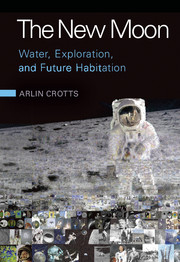Refine listing
Actions for selected content:
17000 results
Index
-
- Book:
- The New Moon
- Published online:
- 05 September 2014
- Print publication:
- 22 September 2014, pp 495-514
-
- Chapter
- Export citation
Chapter 4 - Images of the surface
- from Part I - Views of Venus, from the beginning to the present day
-
- Book:
- The Scientific Exploration of Venus
- Published online:
- 05 September 2014
- Print publication:
- 22 September 2014, pp 48-63
-
- Chapter
- Export citation
Chapter 9 - Inconstant Moon
-
- Book:
- The New Moon
- Published online:
- 05 September 2014
- Print publication:
- 22 September 2014, pp 261-297
-
- Chapter
- Export citation
Chapter 12 - The mysterious clouds
- from Part II - The motivation to continue the quest
-
- Book:
- The Scientific Exploration of Venus
- Published online:
- 05 September 2014
- Print publication:
- 22 September 2014, pp 182-196
-
- Chapter
- Export citation
Part II - The motivation to continue the quest
-
- Book:
- The Scientific Exploration of Venus
- Published online:
- 05 September 2014
- Print publication:
- 22 September 2014, pp 117-118
-
- Chapter
- Export citation
Chapter 14 - Return to Earth
-
- Book:
- The New Moon
- Published online:
- 05 September 2014
- Print publication:
- 22 September 2014, pp 432-462
-
- Chapter
- Export citation
Chapter 9 - Origin and evolution
- from Part II - The motivation to continue the quest
-
- Book:
- The Scientific Exploration of Venus
- Published online:
- 05 September 2014
- Print publication:
- 22 September 2014, pp 119-140
-
- Chapter
- Export citation
Chapter 2 - Mariner and Venera
- from Part I - Views of Venus, from the beginning to the present day
-
- Book:
- The Scientific Exploration of Venus
- Published online:
- 05 September 2014
- Print publication:
- 22 September 2014, pp 17-31
-
- Chapter
- Export citation
Chapter 11 - A volcanic world
- from Part II - The motivation to continue the quest
-
- Book:
- The Scientific Exploration of Venus
- Published online:
- 05 September 2014
- Print publication:
- 22 September 2014, pp 156-181
-
- Chapter
- Export citation
Chapter 8 - Water in a Land of False Seas
-
- Book:
- The New Moon
- Published online:
- 05 September 2014
- Print publication:
- 22 September 2014, pp 227-260
-
- Chapter
- Export citation
Appendix B - Data about Venus
-
- Book:
- The Scientific Exploration of Venus
- Published online:
- 05 September 2014
- Print publication:
- 22 September 2014, pp 291-292
-
- Chapter
- Export citation
Index
-
- Book:
- The Scientific Exploration of Venus
- Published online:
- 05 September 2014
- Print publication:
- 22 September 2014, pp 293-295
-
- Chapter
- Export citation
Chapter 3 - Moon/Mars
-
- Book:
- The New Moon
- Published online:
- 05 September 2014
- Print publication:
- 22 September 2014, pp 58-125
-
- Chapter
- Export citation
Chapter 1 - The Importance of the Moon
-
- Book:
- The New Moon
- Published online:
- 05 September 2014
- Print publication:
- 22 September 2014, pp 1-17
-
- Chapter
- Export citation

The New Moon
- Water, Exploration, and Future Habitation
-
- Published online:
- 05 September 2014
- Print publication:
- 22 September 2014

The Scientific Exploration of Venus
-
- Published online:
- 05 September 2014
- Print publication:
- 22 September 2014
TABLE
- from ON THE THEORY OF THE MOON, AND ON THE PERTURBATIONS OF THE PLANETS
-
- Book:
- On the Determination of the Distance of a Comet from the Earth
- Published online:
- 05 June 2015
- Print publication:
- 21 August 2014, pp 149-166
-
- Chapter
- Export citation
Observations of the Tides
- from AN ELEMENTARY TREATISE ON THE TIDES
-
- Book:
- On the Determination of the Distance of a Comet from the Earth
- Published online:
- 05 June 2015
- Print publication:
- 21 August 2014, pp 267-276
-
- Chapter
- Export citation
CONTENTS
- from AN ELEMENTARY TREATISE ON THE TIDES
-
- Book:
- On the Determination of the Distance of a Comet from the Earth
- Published online:
- 05 June 2015
- Print publication:
- 21 August 2014, pp 218-218
-
- Chapter
- Export citation
CONTENTS
-
- Book:
- On the Determination of the Distance of a Comet from the Earth
- Published online:
- 05 June 2015
- Print publication:
- 21 August 2014, pp viii-viii
-
- Chapter
- Export citation
